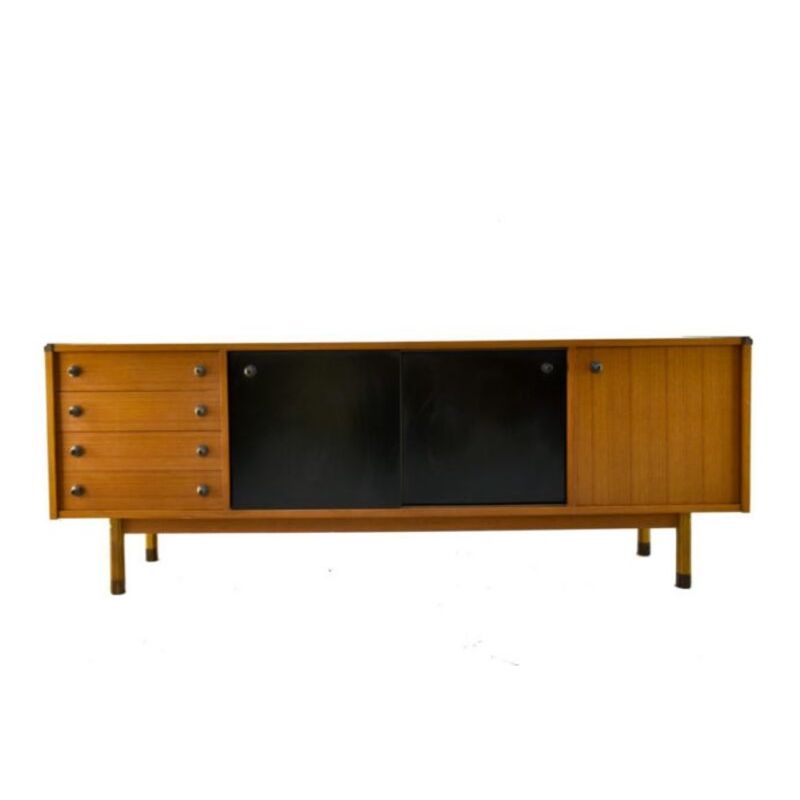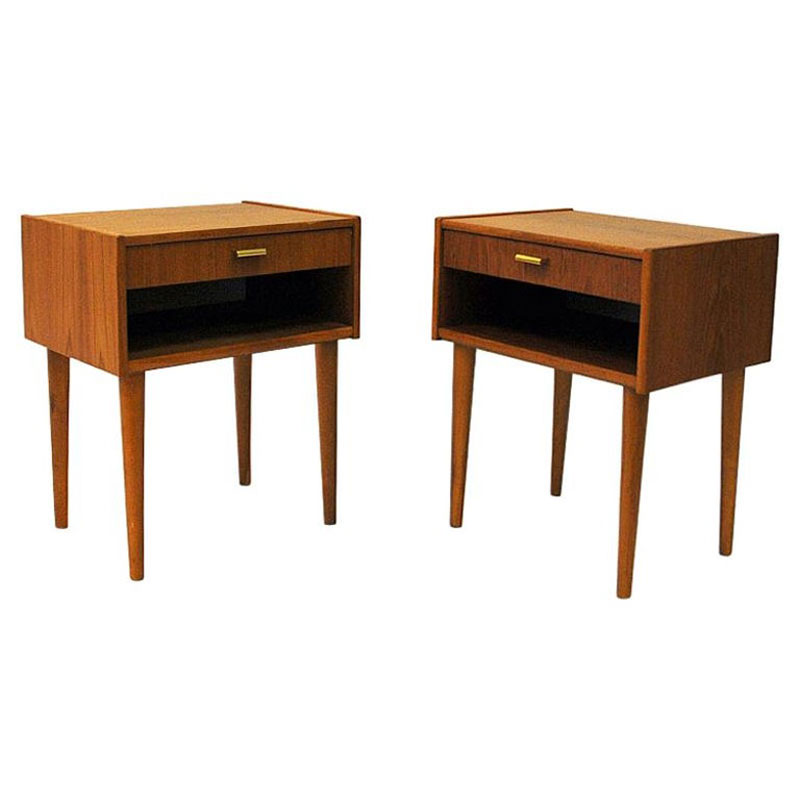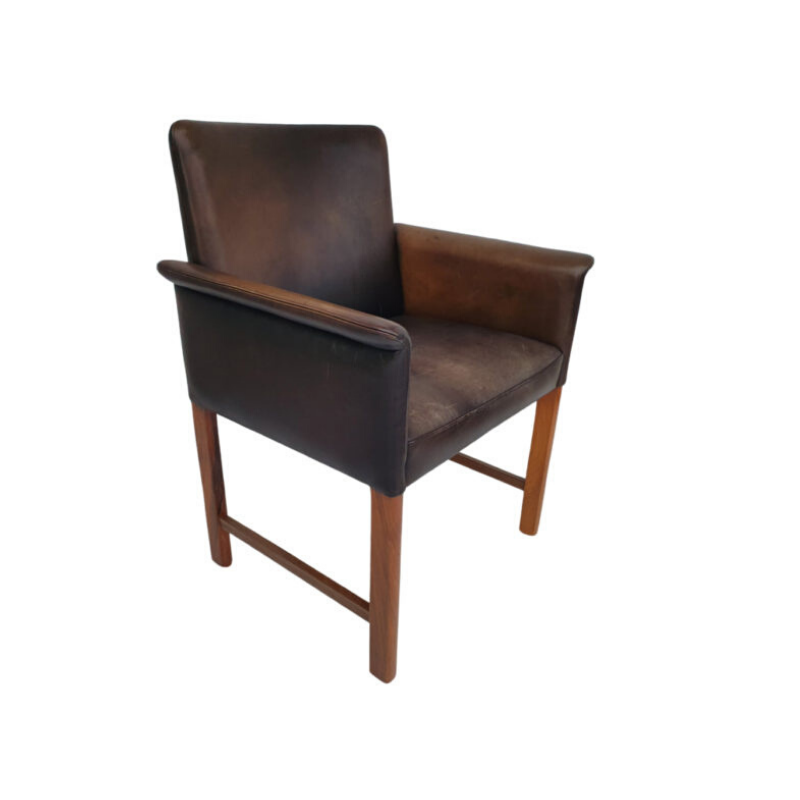On many occassions I have read and heard (especially in decorating mags and the ever-so-popular reno makeover TV shows) that Modern Design began with the Bauhaus. Is this simply the layperson's view, or does it ring true and is the accepted view among the design community? Did it not begin with Michael Thonet's No.14 bentwood chair, from 80 years before? I always appreciated seeing the Thonet chairs in old photos of Charles and Ray Eames's living room and kitchen (in Phaidon's Eames House book), yet when I show other people these photos, they are surprised. Are Thonet's bentwoods Modern.... or are they not?
the birth of design
the birth of 'design' and 'modern' didn't happen in one day. generally accepted 'design' started with the industrial revolution (products must be producable on large scale; 'designers' made this possible), then came arts & crafts followed by art nouveau (that was a 'style', 'designers' implemented that style througout all kinds of products)Henri Vandevelde was an art nouveau architect-designer who also designed the first bauhaus school. In that school, amongst others (de Styl in holland), under influence of the worldwar (standardisation) came the idea of 'purisme' (and they builded an new bauhaus school) and modern design as we known it now. Another breakpoint come with the new industrial revolution after ww2 (mass production, introduction of plastics) and another with the oilcrisis (end of the plastic age). So in short generally accepted is indeed that modernism started with bauhaus Dessau. The Thonet 14 has more to do with the industrial revolution and mass production but because of its different and simplified form/style to achieve that mass production (at that time it was all biedermeier) some call put it by 'modernism'
Beloved
Check out Josef Hoffmann, an austrian architect and furniture designer... he was really on the line between a traditionalist and modernist... his velvet sofa is balanced right on that line, while the "Cubus" sofa and chair for his pavillion at the 1910 Buenos Aires show veers strongly into modernism... he's an excellent example of the birth of modernism...
Although...
Gerrit sketches a nice, compact history of design after the industrial revolution, but Barry is closest to the point...All depends on how you define "Modern", and even more so how you evaluate the real contribution of each period that helped to define Modernism.
I think that the very first contribution was modernism's social and cultural mission as defined by William Morris and friends in the arts and crafts mouvement. Although it rejected almost all aspects of the industrial revolution it build a solid base for two important ideas of the modern mouvement: 1-Products should not simply be the product of machines but be cariers of a cultural message.2-Products should play a role in the social emancipation of the people. An earlier builded corner stone was of course functionalism. The first functionalist credos were formulated by the french neo-gothic architect Violet le duc on this side of the atlantic and later by Sullivan in the U.S.A., based on an older American functionalist tradition. Henri Van De Velde, did more than embracing these ideas and the best of the arts and crafts mouvement. He combined them in what became the goals of the very influential Deutsche Werkbund. As we know he was strongly opposed by Hermann Muthesius and out of that opposition came a even stronger definition of functionalism leading all the way toward Muthesius' ideas on standarisation and design in function of the production process (Behrens) Although Henri Van De Velde's Kunstgewerbeshule Weimar was strong on ideas, it was only when the young Walter Gropius came to replace him in Weimar that the Bauhaus succeeded in finding for all these ideas a new form language. Both Gropius and his staff were rather strong on mmanifestos but weak on ideas, but when it came to giving form to these ideas they were champions! This is of course important from a design point of view. Design is not only a series of well thought out ideas and principles, it is also the capacity to translate them in shapes and colors. Although all the great ideas of modernism pre-date the Bauhaus most of the form language (exeption has to be made for the anti-ornament mouvement with Vienna as it's center) was developed in Weimar. Dutch historians will of course remind me about the importance of "De Stijl" mouvement in the formulation of that form language, and I have to agree, but, one has to take into account that the those who made the bridge (Van Doesburg and Mart Stam) between De Stijl and the Bauhaus were participating and influencial in both.
cont.
This being said, Bauhaus modernism would have gone nowhere if it had not been "Humanized" by an undercurrent of crafts that raised above the surface in Scandinavia and in the U.S.A. with Eames, Bertoia etc. just after the war all coming out of the crafts-tradition-based school of Cranbrook. It was this tradition and it's almost explosive creativity that made the Bauhaus tradition acceptable to a large number of people. If one considers that the Barcelona chair was pre-Bauhaus, the only Bauhaus furniture of some significance in the modern mouvement is Marcel Breuers production. On the other hand, what made Modern widely accepted and known was the painstaking precision of Danish furniture makers sculpting one by one the Wegner chairs. In retrospect we have the tendency to put all well known mid century designers in the same ideological basket. I remember it as a much more diversified time, with a much larger scope of ideas and often dramatic contradictions between the people that are now sharing that basket....but Barry is right, all depends on how you define modernism.
Breaking from Tradition....
Thanks all for your thoughts. In a strange coincidence, the most recent Dwell magazine explores the same question in an article called Mapping Modernism. "More than just a historic survey, tracing modernism proved to be an exercise in pinpointing the ideas, designs, and events that broke from tradition and continue to propel us forward". Creating a timeline, the author Barry Katz declares these as the very "firsts" in Modernism:
Art & Ideas : Daguerrotype (1839)
Events & Institutions : First advertising agency (1843)
Object : Telegraph Key (1844)
Manifestos : Karl Marx and Friedrich Engels, The Communist Manifesto (1848)
Structure : Joseph Paxton, Crystal Palace (1851)
With a caption :
1890-1915
By the end of a tumultuous century, the modern industrial system was securley in place, and artists, writers, designers, and architects were taking sides in a vibrant war of ideas. Inspired by John Ruskin and William Noriss, members of the English Arts and Crafts Movement argued that the "lesser arts" of everyday life were equally deserving of artistic attention. But impatient with their nostalgic medievalism and stimulated by the opening of Japan, others soon began calling for an Art Nouveau, a new art that expressed the speed and energy of the new century.
Any thoughts? According to this interpretation at least, our beloved Modernism does appear deeply rooted in the 19th century.
BTW, Barry Katz does define Thonet's No 14 as a Modern object.
koen...pt.1
this is a brilliantly clear and distilled summary of the many tributary streams that flowed together improbably to produce the river of modernism.
First, I had always wondered exactly what the Bauhaus collective contribution had been to modernism, beyond just being a place where a number of very talented persons converged for a time and produced some very designs. Of course: they created/established a common formal language of modernism.
Second, I had always wondered what the catalyst was that made the Bauhaus' astringent strain of modernism evolve into something as delightful and as easily consumable as the Eames' work, on the one hand, and as tactilely (sp?) and sensually fulfilling, as Danish modern work on the other. But of course: the arts and crafts movement! And Cranbrook became a Petrie dish where this hybridized strain of modernism sprang from. Marvelous. Marvelous. Thank you so much for sharing this insight.
Question 1: was their an equivalent of Cranbrook in Denmark, or was there instead simply a very familiar craftsman's guild in which all could informally associate and synthesize what the others were doing along these lines?
Question 2: in modernist literature and painting, first Paris (before the fin de siecle, then London, before 1914 and the Great War, and then Paris again, between the end of the Great War and the ascent of the Bauhaus, were seminal springs of Modernism. Did modernist design flourish in those places along side painting and literature, or had design not yet come into its own as distinct discipline?
koen...pt.2
Supplementary Observation: modernism seems fatefully intertwined with war and internationalization. modernism, as you said, had a precept that said, "...products should carry a cultural message." the 20th century saw decisive trends toward unlimited war and toward internationalization of trade and politics. both these trends obsoleted many traditional state boundaries and notions of separate, homogeneous cultures to say nothing of triggering slaughters on unprecendented scales. And this trend toward unlimited war had come on the heels of a 19th Century in which regionalization had swept away most of the feudal boundaries (plus the Hapsburg Empire overlay) and subordinarted those feudal societies of Europe in new and relatively contrived federalized states like Italy and Germany and France. And simultaneously there was the great federalization of the United States.
A significant result of all the above was a dramatic divorce of human beings in the west from feudal and ethnic social frameworks and a forced realignment of these persons with more purely state and firm centered frameworks of living within their city, town, village and agrarian patterns of settlement. This shift from localized feudal structures to more regional state and firm structures of organization and trade almost certainly contributed to a breakdown of the old cultural symbols and myths and ways of coping with things that ordered the thinking of these societies in their production of architecture, artifacts, art and literature. In essense, the 19th and 20th Centuries regionalization and internationalization triggered a massive cultural obsolescence, whether intended or not. And of course all of the internationalization of the 19th and 20th Centuries was facilitated/propelled by fundamental technological changes that had been accruing on the heels of the enlightenment. It made western civilization technologically avant garde, but encumbered it with a creaky, ill-fitting cultural framework in view of many early modernists.
koen...pt.3
I have tended to view modernism as one of many secular attempts to adapt symbols and mythologies and ways of relating and responding to the society that humanity and its technology finds itself now ensconced within. Put simply, western society had by 1900 reached a tipping point of massive unmet demand for new, better fitting symbols and mythologies needed to inform everything from poetry, to stories, to music, to artifacts, to architecture, to clothing, etc. Modernism was/is one approach to satisfying that unmet demand. To wit, the Bauhaus offered up a new more rationalized and secular vocabulary of forms. To wit, Cranbrook mixed it with crafts movement sensibilities and transformed it into something western societies could more readily and widely embrace. To wit, post modernism tried to broaden its appeal even further, rightly or wrongly, by introducing a sense of humor and a puncturing of the secular piousness of modernism. And the fact that Michael Graves and Starck's stuff are in Target and Kareem Rashid is hither thither and yond is a testament that modernism, redressed as post modernism, can however briefly (and perhaps unfortunately) be further mainstreamed.
And the reason, of course, that modernism is still relevant after over a century (at least the way I define modernism) is that technological change has kept ACCELERATING and forces of regionalization and globalization have dramatically broadened and so cultural obsolescence has increased no matter how fast society has struggled to keep up. For this reason, I am constantly opposed to modernists simply recycling earlier modernism. For this reason, I am constantly in favor of modernists trying to design rigourously and profoundly to the moment, like Koen advocates. There is vast increasingly structural unmet demand for escape from cultural obsolescence and that demand is growing, not shrinking. Modernism to me, to the extent that it is relevant, is a debate about the feasible paths to fulfill that unmet demand.
koen...pt.4
Now I began this observation saying modernism was fatefully intertwined with war and internationalization and I have focused almost entirely on internationalization. I have done so, because I view war as simply a horrendous polluting by product of that process of internationalization. Regardless, however, war has recurring had decisive effects on modernism. The Spanish American War and the early empire building of America awakened early American literary figures like Henry James and Ezra Pound in the generation following James, that America was no longer a nation seeking to be a lighthouse for constitutional republicanism. They became aware it was a nascent empire bent on regionalization and internationalization. Thus they became, intuitively in James case, and intentionally in Pounds case advocates of modernism. They gravitated to London, the seat of the British empire, expecting a troubled but potentially magnificient confluence world of empires that would need a new art to characterize and explain itself. And they were profoundly right. And painters flocked from all over the world to Paris once again to seek out a new visual vocabulary for a world rapidly transformed by technology into regionalization and internationalization. But it was the Great War the crushed the hope of an entire generation or two of artists. Pound said it best in Hugh Selwyn Mauberly. Eliot said it most memorably in The Waste Land. And Hemingway said it most popularly. What ever this vast regionalization and internationalization is heading, it is alienating to the individual in an unprecendented way and it is being driven by forces fundamentally hostile to ordinary persons and it is not something anyone has any clue about how to stop. In that sort of a world, these writers and all the associated painters said, here is the best new vocabulary we can come up with for humanity. It is secular. Godless. It is based on rationalized forms filtered through subjective lenses of perception. It strips away the phony and builds for the future on essential knowns that reach back in a legacy as far back as we can go--to classical antiquity. And it is combined with the real and observable that is out in the street in front of us every day.
And then Guernica and the Spanish Civil war and Picasso brought the point home that modernism in any form could not adapt a framework of symbols and myths that prepared one for avoiding the next unlimited war of regionalization and internationalization.
And then the sudden awareness that German/Japanese/Italian dictatorships occupied half the world and unlimited war would sweep the world and no set of abstractions could posit symbols and mythologies that rationalized it.
koen...pt.5
And then UNLIMITED WAR in capital letters swept much of the world. An even though forces of constitutional republicanism won out and lead to a euphoria of escape from the forces of darkness that created a gestalt the Eames tapped into in the design of artifacts, there was an unmistakeable existential realization that the technological forces that unleashed two great wars and exposed the inadequacy not only of political structures, but of cultural and artistic structures, to cope with the rising tide of technology and the ensuing regionalization and internationalization that it unleashed,; that all of that was still completely out of control. And the world resided under a black umbrella of nuclear annihilation.
And since that time, we have added genetic warfare, chemical warfare, digital warfare, weather warfare to the list of the ways to extinct us all.
And modernism, which is more necessary now than ever, seems to be staggering like a punch drunk fighter, looking at what it once was, rather than hurling itself back into the frey and trying to reconjure symbols and mythologies capable of sustaining humanity and perhaps even of pointing to a passageway as yet unrecognized, but felt, that might lead humanity out of the madness.
Dear dcwilson...
As you might expect it was easier to answer the "cat-vase" question...
I am sure you do not expect anwers on all your questions your rich observations are raising. Allow me to start with the least complex ones.
Cranbrook shared with a number of other European "art and or craft" schools the stimulating tension between their cultural mission and their role as educators of craftmanship. Eliel Saarinnen and the Finish and Swedish staff he had invited to join him in building Cranbrook, were all representatives off this dynamic, unsolved duality. In my humble opinion, those schools who have chosen to be one (technical) or the other(artistic) are the dull and un-inspiring ones. The restless and endless discussions between those who advocate that you first have to develop the means to express yourself and those who believe that if you have something to express you will find the means to do so, makes for a dynamic and stimulating learning environment.
If your first question was: "Was there a n equivalent to that in Denmark. The answer has to be yes. Modern Danish design, especially furniture can not be dissociated from this continious search for a balance between "skill" and "innovation". In fact many of the great designs we now recognize as significant for the modernist period were first show pieces for the annual show of the Danish furniture makers association.
Gustav Stickley...
..and in a more commercial way his brothers weere indeed important in bringing the "arts & crafts" (specifically the William Morris/John Ruskin version ) to the U.S. He certainly translated the ideas into typical "american" form, but it was still based on a British mouvement. I think a more convincing case is the lineage: William LeBaron Jenney (1832-1907) Louis Sullivan (born two years earlier than Stickley) and Frank Lloyd Wright. Yes, Jenney had been educated in France but his First Leiter Building is not based on this french tradition.
If you need any help, please contact us at – info@designaddict.com









